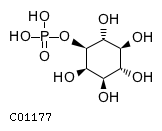
CHEBI:18297
| Name | 1D-myo-inositol 1-phosphate |  |
| Synonyms | 0(1s,2r,3r,4s,5s,6r)-2,3,4,5,6-pentahydroxycyclohexyl phosphate; 1d-myo-inositol 1-phosphate; 1d-myo-inositol 1-monophosphate; 1d-myo-inositol 1-phosphate; D-myo-inositol 1-phosphate; Inositol 1-phosphate; Ins(1)p1; Myo-inositol 1-phosphate; Myoinositol 1-phosphate; | |
| Definition | An inositol having myo- configuration substituted at position 1 by a phosphate group. | |
| Molecular Weight (Exact mass) | 260.1358 (260.0297) | |
| Molecular Formula | C6H13O9P | |
| SMILES | O[C@H]1[C@H](O)[C@@H](O)[C@H](OP(O)(O)=O)[C@H](O)[C@@H]1O | |
| InChI | InChI=1S/C6H13O9P/c7-1-2(8)4(10)6(5(11)3(1)9)15-16(12,13)14/h1-11H,(H2,12,13,14)/t1-,2-,3+,4-,5-,6-/m1/s1 | |
| InChI Key | INAPMGSXUVUWAF-UOTPTPDRSA-N | |
| Crosslinking annotations | KEGG:C01177 | 3DMET:B01403 | ChEBI:18297 | ChEMBL:CHEMBL3959608 | KNApSAcK:C00007483 | NIKKAJI:J6.548J | PDB-CCD:IPD | PubChem:4404 |
| Pathway ID | Pathway Name | Pathway Description (KEGG) |
| map00562 | Inositol phosphate metabolism | NA |
| map02010 | ABC transporters | The ATP-binding cassette (ABC) transporters form one of the largest known protein families, and are widespread in bacteria, archaea, and eukaryotes. They couple ATP hydrolysis to active transport of a wide variety of substrates such as ions, sugars, lipids, sterols, peptides, proteins, and drugs. The structure of a prokaryotic ABC transporter usually consists of three components; typically two integral membrane proteins each having six transmembrane segments, two peripheral proteins that bind and hydrolyze ATP, and a periplasmic (or lipoprotein) substrate-binding protein. Many of the genes for the three components form operons as in fact observed in many bacterial and archaeal genomes. On the other hand, in a typical eukaryotic ABC transporter, the membrane spanning protein and the ATP-binding protein are fused, forming a multi-domain protein with the membrane-spanning domain (MSD) and the nucleotide-binding domain (NBD). |
| map04070 | Phosphatidylinositol signaling system | NA |

